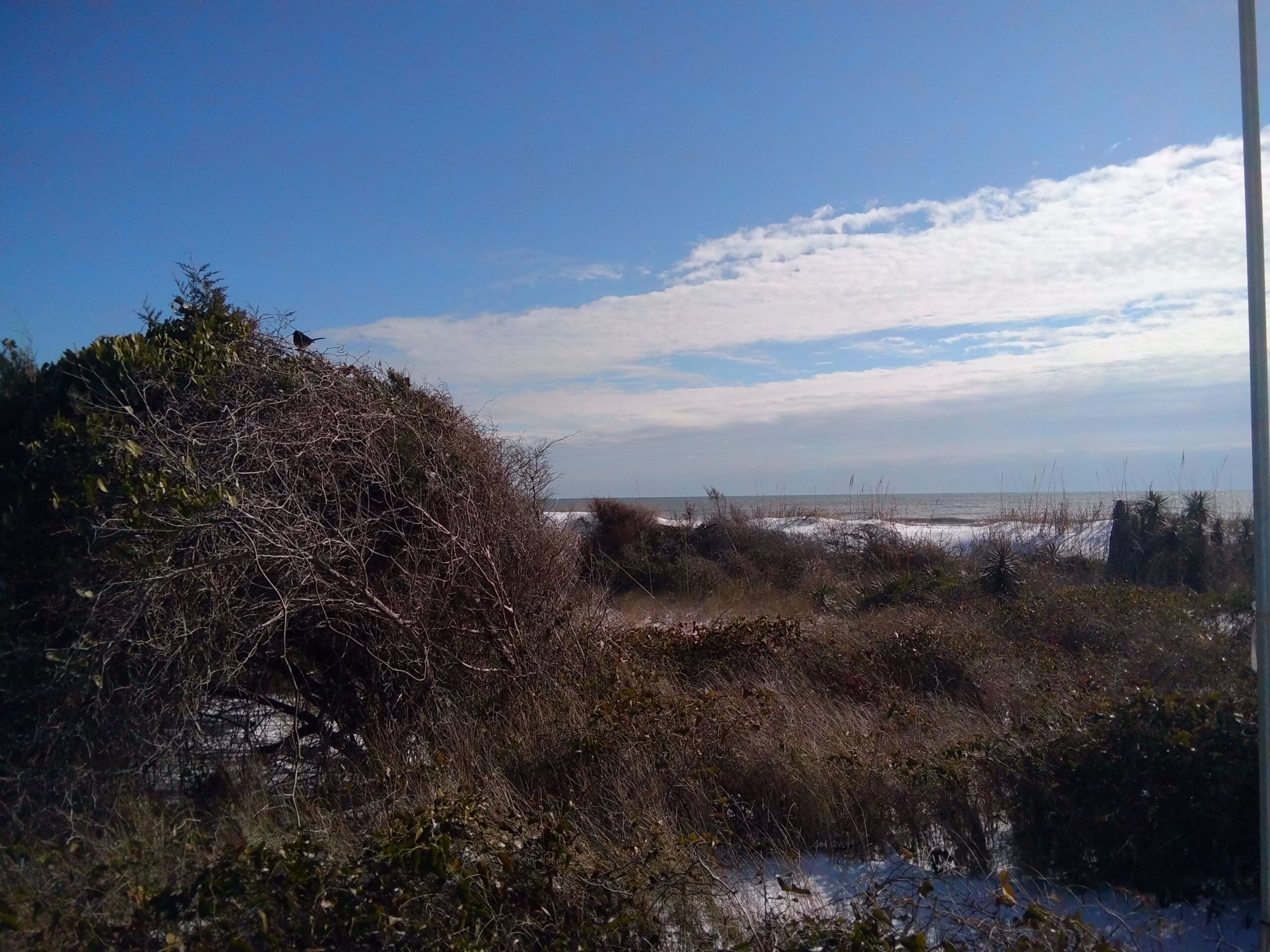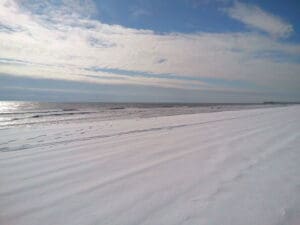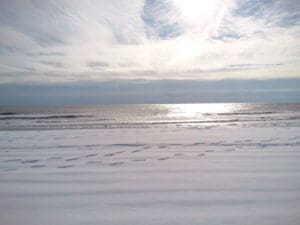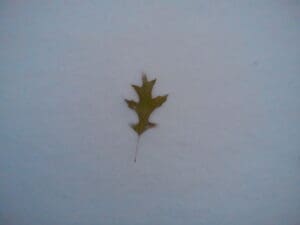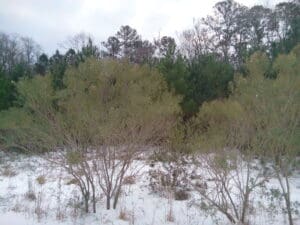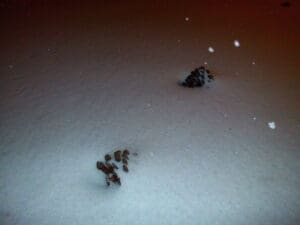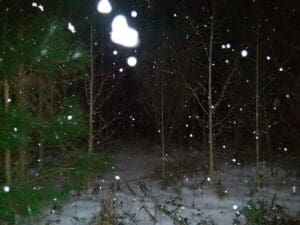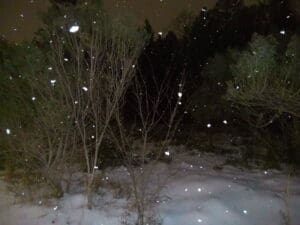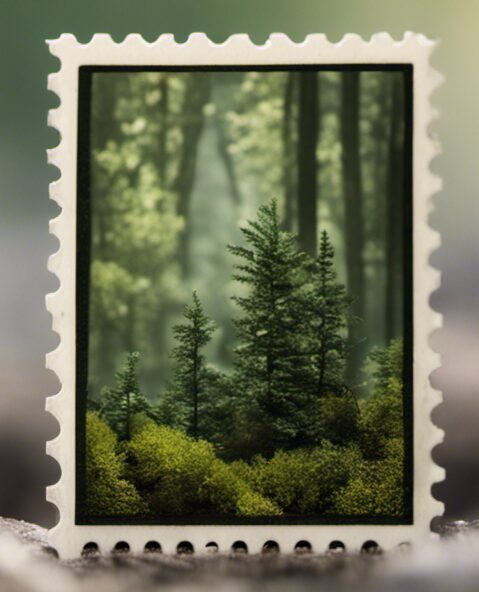A Personal Journey of Winter with Ecology, Native Plants, Climate Change, Experiences, Feelings, and Music

Misty cool winter Myrtle Beach in 2023. Credit: Jason L. Flynn
A cold rainy mist blows inland off the Atlantic Ocean and through the coastal plain after autumn passes. A fog then accompanies reminding you that winter in South Carolina is a season of relief, and general coolness relative to the hot and humid summers that entrench everything during the summer season of biomass growth with many native plants of South Carolina. When experiencing the weather of winter firsthand sometimes an ancient feeling returns to the subconscious mind perhaps originating from our ancient ancestors who endured much colder, frigid, and Canadian-like winters in South Carolina just after the end of the last ice age and in subsequent mini-cool downs such as during the Little Ice Age (not a true ice age but just named that because of cool downs and weather variations, the full extent of which is not known).
Yet we modern humans seem to have shorter attention spans and less understanding internally of the vastness and mystery of the distant past in many circles, despite more knowledge being gleaned of the past in many ways through research. The weather is no different for humans in this regard. Most people in the day-to-day modern urbanized and suburbanized world view the weather as something that needs to be adjusted to their personal needs. Just an example of more detachment as a result of sheltering and gleaning from the land for our survival in a thirdhand manner rather than doing it firsthand in the not too distant past.
Crisp air, chilly air, cold air, bone-chilling air slams into exposed skin in a winter setting. The eyes require the cold air to hit them to stay alert, to see what is coming from every direction. Breathe it in; take it in, chin up, eyes forward, conscious outward, alert in the moment and the winter setting you currently reside in. Realize you are part of something larger, just yourself, not your clothes, not your social status, certainly not your cell phone or whatever the technological stylistic obsession of the era is. Just you and whoever you are in company with, whether physically with you, or with you in your heart and soul. Winter, with its invitations to stay warm also brings forth bonding between people on many levels as a byproduct along with appreciation for life of all types.
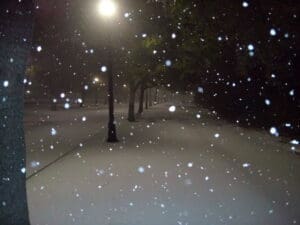
Live oak-lined street during a night snowstorm in Myrtle Beach – 1/21/2025. Credit: Jason L. Flynn
It’s a time of dark surpassing the light day in and day out in the northern hemisphere. The coldest times of the year create appreciation for the warmth, or a welcome relief from the oppressive warmth of summer, depending on your view and choice. The daily cold, whether in damp or dry form, almost negates the fact that daylight is actually increasing during the season of winter, though be it at a snail’s pace. Rest, relax, and rejuvenate your energy. Reflect on winters of the past.
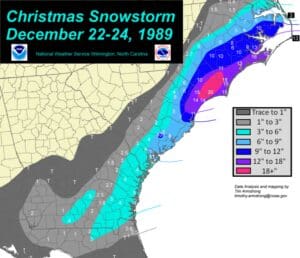
Map courtesy of NOAA – National Weather Service, Wilmington, North Carolina
And mild air surprises the senses every now and again in the winter, but it’s not the same. 70 degrees in the winter feels strangely warm. 70 degrees in the spring feels just like a natural state of being. A fleeting 70 degrees in the middle of summer feels like the most relieving gift imaginable to the core of every living thing in South Carolina. And 70 degrees in early autumn after an oppressively filled marathon of heat and humidity in the summer can feel like a magical gift awakening the electric sensory experience of autumn. But it’s all 70 degrees. Why should we as humans, or native plants, react differently to this same environmental stimulus at four different times of the year in South Carolina’s temperate subtropical climate? The answer is because 70 degrees is not always 70 degrees. Humans today measure, analyze, and make determinations in a stagnant manner based on stagnant fixed numbers. No, 70 degrees is really never ever 70 degrees. The dimension of time, upon one way of analyzing, is fluid, not fixed. That measurement of 70 degrees is actually in the process of changing, even if in the rare times the ongoing change is at levels barely conceptualized by the human brain. Native plants learned this commonly unacknowledged aspect of time perhaps many hundreds of millions of years ago and are not giving away their cherished secrets of understanding it so easily.
Slow, slow, self-indulgent humans. Tisk- tisk, think the native plants. “This human species does seemingly have a bad case of long timeline collective amnesia” the plants say to each other in their gab sessions of chemical communications.
Inconsistencies in South Carolina winter weather always seem shocking to the system. Our being seems to want to associate these in-season swings with a greater seasonal change into the next season (perhaps this is just wishful thinking that a particular favorite season of easier life for humanity, like spring, could last year round). Yet the body’s health can sometimes be better prepared to a consistent weather extreme as opposed to wild swings. Why is this? Well it could be because it takes time and extra energy for the body to adjust to great swings in the weather, hot or cold. Some of it is mental. Free will and mental focus is powerful, especially together. Collective human focus of intention is a force not well understood in the scientific field of study, but one seen throughout cultures and religions, such as seen with communal prayer. Why do humans now seek climate-controlled indoor living in most developed countries around the globe? It is considered the norm because of this very reason, to reduce stress on the body. Author, Aldo Leopold stated in his iconic book A Sand County Almanac: And Sketches Here and There in the essay entitled “Thinking Like a Mountain,” “…but it all comes to the same thing: peace in our time. A measure of success in this is all well enough, and perhaps is a requisite to objective thinking, but too much safety seems to yield only danger in the long run.” But human adaptation and personal preferences are sometimes what the brain grows unconsciously used to over time, whether we individually chose it, or were born into these circumstances of being in the modern world. Some of it is influenced by what society says. For example, it has been said by some living in rural areas from around the country multiple generations ago who never experienced a town of any size most of their lives, that “we did not know we were poor until someone from a big town came in and told us we were.” The collective hive mind of humans needs to be sanely examined sometimes from afar to ensure it is not harming all living things long term for short-term sensory pleasure of the addictive human mind.
The old and very wise saying dust to dust does apply. Our Earthly journey and all of its important events and purposeful growth on many levels, turbulous to joyous, all physically lead us back to Earth at the end of our lives. Winter brings this reality to the front.
Winter Invites Reflection Naturally
I had to use an eraser on a pencil, scratch over words with an ink pen, and use my backspace button many times when writing this article. Misunderstanding what I was trying to say and communicate actually led to further understanding my writing though. So, was it a bad thing to have had to make those corrections? Such a large question is really beyond my or anyone else’s right to answer definitively it would seem. This internal strife of mine could have resulted in this article being scrapped as another possible outcome had my desire, fortitude, and will been different. So, again, was my temporary internal misunderstanding a bad thing to have happened while I was writing? If I had written perfectly in line with what I am trying to communicate without correction the first time, that would not have been a bad thing either it would seem. But that is not what happened and not what I did. So, I moved forward and hopefully learned from momentary misunderstandings of myself. Of course, learning to understand myself did not come completely from my own internal learning. That would seem impossible for anyone. What I know about myself is also shaped from how I have interacted with and understood the outside world. As you can see this is a rabbit hole, a deep rabbit hole, and one that seemingly has no answer on the immediate horizon (perhaps it should not have an answer at this time). But that does not disqualify this as an aspect of understanding the nature of being human and a living being at all! In fact, we as humans may shy away from these deep thoughts or disqualify them much to our own long-term detriment. But sometimes pain, or moderate struggles, can lead to growth and capacity for better understanding on all levels, much like consistent exercise and weight lifting can increase muscle size, lung and circulatory health and capacity.
Misunderstandings are part of being an individual human and of being part of a species that must rely on each other for survival every day, whether directly, or indirectly. When you stay home alone, relaxing, reading, watching TV, or whatever, to rejuvenate one day, did you make all the things in your house or come up with the idea of television? Religions, self-help, spirituality, all these have one aspect to them that seek to help reduce misunderstandings of all types to the benefit of the self and to all. The enigmas of human understanding sometimes humble us; give freedom, and the ability to strive to not misunderstand in a deeper way than any artificial intelligence ever will be able to.
This spirals outward to every vein of existence. We are part of nature, the Earth, the solar system, the universe, the cosmos, and on to what we cannot see with any of our known five senses. Human understanding of the season of winter is also strife with misunderstandings and, in all honesty, aspects we simply have not been able to learn and understand yet on a long-time scale. Winter, it would seem, does not understand all aspects of humans either. Yet we coexist and in fact need each other (well maybe winter does not need humans). Though you would not know that based on some humans’ attitudes of the season of winter, and how we and native plants interact with this result of the north pole in the northern hemisphere rotating away from the sun in autumn and releasing the resulting winter weather, as the north pole slowly wobbles back towards the sun during the actual season of winter, on its much sought-after march to the season of spring.
Humans don’t understand winter and we don’t relate to how a native plant sees winter. Native plants and humans are both living and filled with energy passing at a certain frequency rate, yet we are different. Humans seek comfort and security in the mind perhaps more than in the body. The universe is massive. Winter is massive. Plant interaction with humans and every other aspect of the Earth and the environment is massive. We are really babies in the cosmos at the mercy of the good nature behavior that interconnectivity can bring (or at the mercy of Something Greater, would be a better phrase). So just like a baby seeks security from its parents, so do we from our environment and seasons. But sometimes fighting to remain secure when the season of winter is trying to talk to us and communicate valuable information is detrimental to our survival long-term. For example, a child might eat sugar all day and become very unhealthy in many cases if it was left to completely decide for itself based on its existing knowledge level. So perhaps humans need to take a step back and look, listen, and understand before forming our own idea of what the beautiful season of winter should or should not be. Perhaps humans should see if our current idea of what winter should be in some thought processes of daily life is not based more on self-indulgence that could be harmful to the ecosystem in the long run.
So what does that mean for us impatient humans that do not go dormant for the winter months like our native plant neighbors in the community do? We should not force a native plant to be like a human in its growing nature. It can’t and it will not! Just another reason humans embrace many non-native plants in the garden that give us what we want superficially in the slow growing and dormancy months, much to the detriment to the ecosystem and us humans physically long-term. How can this poor practice change then? Well, we should understand that humans collectively seem to have a bit of a hive mind, or collective unconscious that adjusts slowly, much like the seasons do on Earth.
So what do we humans do in winter while we acknowledge this aspect and grow to allow the collective unconscious to change where we see a native plant reacting naturally as normal? Struggle inside? We can do that and change in some cases, sure. But in general that is not really healthy and could invite forgetting all we have learned. So we stay active in winter and make it productive. In winter we should plan, learn, dream, and grow internally. In plant vernacular, let our human native plant psychic energy store up and then spring forth with vibrant growth into the future.
Simply put, here is a quick, simple, and ecologically conscious way of caring for our native gardens in the winter that acknowledges our garden is not just for us. It is for the health of many other living creatures that we share our local community with. This process can also have benefits for us humans in the long run.
- Leave the fallen leaves, dead stems, and growth from the previous growing season after dormancy has set in. This is a hotel of sorts for next year’s insects as well as a habitat for other animals of all types (including birds) to find food and shelter over the slim winter months.
- For a true mental challenge that will improve blood flow to the brain because it can be so difficult, go out and try to identify many native plants in the middle of winter dormancy. Not only will that force one to improve personal identification of native plants, it will allow one to truly notice the immense details of change that occur in late winter as plants emerge into their spring growth. But don’t forget to see the forest for the trees, as the saying goes. A step back looking at the big picture helps keep a balanced perspective along with detailed individual plant study.
- Once the first spring growth of some perennials is visible at ground level and temperatures stay consistently above 50 degrees, cut your native garden’s dead stems back. Though the plant will be just fine if you do not do this at all and will grow like normal (mass cutting back does not happen in the wild, remember that). This cutting back is an acknowledgement of the reality we as humans face in some modern environments. Scatter this cut back refuse in the garden bed if possible. Remember, the old simple adage, put back in what you take out of nature.
- If leaf litter, pine needles, or other natural debris in your garden bed is extremely thick, once at the same stage weather-wise for cutting back occurs, GENTLY rake back SOME of this debris to expose the emerging plants. Leaving the leaves is fine if it does not form an unnatural thickness that would not occur in a natural situation in the wild. This can occur in a suburban manicured landscape sometimes where leaves blow over an unnaturally clear ground level landscape, hit your native garden, and pile up to unnatural depths, thereby smothering your perennials in the spring from emerging in extreme cases.
- Looking south on the beachfront in Myrtle Beach as a snowstorm departs the coastline – 01/22/2025. Credit: Jason L. Flynn
- Edge of a snow storm from 01/21 and 01/22/2025 drifting off the coast of Myrtle Beach that left 5 inches of snow and persisted for a few days. Credit: Jason L. Flynn
- Oak Leaf fallen on fresh snow – morning of 01/22/2025 – Myrtle Beach. Credit: Jason L. Flynn
- Snow-covered forest land in the city of Myrtle Beach with native Groundsel Tree in forefront 1/22/2025. Credit: Jason L. Flynn
- Pine cones buried in falling snow – late night 01/21/2025- Myrtle Beach. Credit: Jason L. Flynn
- Native sweetgum and pine trees at the edge of a forest lot in Myrtle Beach during snow – night of 01/21/2025. Credit: Jason L. Flynn
- Baccharis halimifolia – Groundsel Tree at the edge of a wooded lot in Myrtle Beach during the night snow storm of 01/21/2025. Credit: Jason L. Flynn
Climate Change and Winter
South Carolina’s winter weather is not its own (nor any other season’s weather for that matter). No weather is really produced in any one spot. But what South Carolina experiences in winter is in the middle of a weather freeway, or battleground based on its longitude and latitude location and global air patterns. In a sense, the equator, the poles, stay the most consistent in terms of weather being felt either being considered cold or hot. So as the equator and the poles display changing weather patterns, so does change occur in South Carolina’s weather patterns. And since the majority of Earth is a water world of oceans, it would make sense that what the sea produces affects South Carolina and mixes into this always self-regulating planet.
The arctic is warming! Forget any self-indulgent lip service given by any media outlet; it’s simply a current fact of noticing the trends. Talk to residents of Alaska of any persuasion and you get the same story. Forget any politics, when the U.S. military spends great amounts of time running future scenarios planning for an almost iceless Arctic Ocean internally, then you can bet, on a down-to-Earth non-media level, the government takes it very serious, regardless of public political squabbling over climate change to help increase and addict the public to TV and increase media ratings and views.
And warming ocean temperatures consistently across the planet also affect South Carolina’s weather. Living in the Grand Strand region of South Carolina has proven the sea’s impact on temperatures and weather since before humans could collectively understand weather trends in the modern scientific ways. There is a reason in the geological classifications of the state of South Carolina, there is a sub-region of the Lower Coastal Plain called the Coastal Zone. The dynamic and overpowering ocean not only actively impacts the geological integrity of this piece of the Lower Coastal Plain stretching roughly ten miles inland, it also impacts the everyday temperature and weather patterns with or without extreme global climate change compared to the rest of the coastal plain and the entire state.
We rarely think about the equator in the winter but its weather certainly has impacted our general South Carolina winter swings in modern times. When arctic air comes down in the jet stream as an arc, polar vortex, or whatever, it can push up warm air in front as one weather pattern seen. If that air being pushed up is consistently much warmer in the tropics this time of year, so will ours be also. Love it, hate it, or indifferent, because one may spend 99% of their time indoors in modern times thinking about anything but the weather, plants, or the natural environment, it is all impacting each person in ways understood and not understood or even fathomed by the limited time-space perception of humans.
The arctic regions at the poles are shrinking. The tropic regions at the equator are growing in modern times. The ocean waters are warming. Winter is getting warmer and starting later and ending earlier by trends observed. What are the long-term effects of this triple threat going to give the Earth?
Winter and climate change, climate change and winter. Climate change and winter are not mutually exclusive to each other and never have been in the past 4.5 billion years that the Earth is thought to have existed. Every other season on this planet experiences climate change. However, from a human perspective in South Carolina in the summer, whether daily temperatures are consistently warmer for a high and low on average, which has been the case in recent years, makes little difference to us living through it. In South Carolina, it would still be defined as hot and most likely humid! A day with 96 for a high or 92 is still hot with either. Perhaps modern climate change expression in the night during the summer is more noticeable at 72 compared to 79 for example. But during the night time the majority of the populace is nestled in or perhaps sweating away in Dreamland.
But these days and years, no other season allows climate change to be felt and measured in such noticeable ways than in the season of winter. Winter is a season that is entrenched in the human psyche in the northern hemisphere above certain latitudes around the planet. So goes winter, and so goes the other seasons in many ways. A warmer-than-normal winter can lead to an earlier start to spring, which can lead to a longer-than-normal summer, which can lead to more warm air fuel built up to potentially delay typical autumn temperatures from knocking on the door.
So goes winter and so goes native plants, both in the here and now, and in the distant future. There is a giant jigsaw puzzle of understanding to the reactions in these modern times of native plants and the effect of climate change. To understand this interaction today requires at least a small trip in a time machine towards what we humans consider the distant past, usually measured in small geologic time scales. Where the Earth has been can tell us about where we are going. This interconnection and the future of many native plants are more visible with the understanding of the environmental impact we are having on the planet in many obvious ways and many not-so-obvious ways today.
To sum it up climate change is complicated! And to anyone who is realistic and honest with themselves, much about climate change is unknown. How can it not be? The Earth has been here 4.5-4.6 billion years and we humans have been studying this subject, in some form or fashion under one description of study or another for maybe 200 years in modern ways.
At first understanding this might seem counterintuitive, but the lack of ability for a native plant to adjust to drastic climate change is a sign of adaptation and evolutionary strength of the plant in some ways. That is before humans altered and fragmented the surface of the Earth where native plants dwell. If global temperature and/or precipitation levels change to great measurements consistently to where they turn the weather patterns unrecognizable to what a plant flourished in for many years in the wild, it would take quite a lot of drastic change in energy output of the plant to be able to survive those new conditions. The same can be said for the insects and food web chain that follows the plant and needs it to survive. When our ancestral hunter-gatherer societal collective actions to avoid major shifts in the climate is considered as a comparison, it’s easy to see a pattern of human migration to new areas that made living and surviving easier and less stressful on our energy output, which in the wild can lead to a longer life expectancy. A native plant on a long scale of time does this also as a population of plants, it migrates. Some plants will not survive change. Extinction has been occurring forever due to natural climate change. Whether few or many species go extinct, or extreme or mild climate change occurs, native plants on the edges of populations have historically still spread seeds through many methods that nature helps precipitate to non-viable areas. As the climate changed, these seeds present in areas that had not been previously conducive to growing the plant became conducive and the plant population in a sense was able to migrate.
If the climate alters to the point many native plants no longer are able to call South Carolina or their current native range home, there will be a much greater chance of mass plant extinction than has been experienced on planet Earth in similar climate situations in the past. This is because of the fragmentation of the land in South Carolina and across the U.S.A. in great amounts east of Rockies from paved roads, urban cities, suburbia, and large swaths of various forms of agriculture. The native plant seed bank in post-colonial South Carolina’s abused soils has already been depleted and sterilized to varying large degrees in the truly natural lands that still exist. These already human-altered native plant ranges and the seed bank in the soil will not mesh well with global climate change.
Some experts say that whatever changes we as humans make at this moment to stop human-made climate change will not matter in the short term. Back to the concept of momentum for a moment, just like the coldest weather experienced in winter does not match the fact that daylight is slowly increasing as the Earth starts its return to having the North Pole facing the sun on its axis rotation, it would make sense that human-made climate change impacts would take time, perhaps in the form of years, to build up and express, despite our changes of actions.
Will human-induced climate change take on the same expression long-term as what has been uncovered in ice core samples showing how dramatic climate change played out in the distant past? That is a valid question. Despite the extreme responses of either bleakness, or utter dismissal of the subject, that seems to come out in some futurist scenarios, a world without extreme human induced climate change seems like a more conducive planet to live on for native plants, humans, and all living organisms in the long-term.
Native Plants and Winter
From a strictly visual perspective of spring, summer, and autumn’s varying stages of growth, winter on the surface can seem like many a native plant decided to give up trying. While not said specifically, the modern world sees winter as a lazy unproductive season that simply holds back the GDP and economic growth. Oh such a shallow way of looking at the world. A native plant garden and wild field full of brown, tan, and black stems would seem to not be of any good to anything from a suburban perspective. Just more detachment from reality in modern times rearing its head.
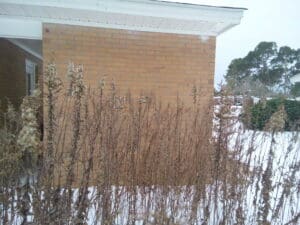
Native goldenrod at author’s home garden covered in snow – Myrtle Beach – morning of 01/22/2025. Credit: Jason L. Flynn
The truth though is sometimes very different than perception of the human ego. The current collective of nature’s web has adapted to winter in South Carolina. From an animal comparison perspective, the truth is humans are not the brightest or most acute animals in many ways. We are very much “out of sight, out of mind” which is counter to much of the rest of the animal kingdom, many species of which spend their entire lives preparing for what comes next. Do we do that? Hardly, especially in modern times. There is a misconception that many birds, butterflies, insects all simply migrate away from the dormant times of winter. So why would you not get rid of all the signs of winters’ presence on a plant in a native plant garden or wild field? While true for some, such as monarch butterflies, many though do not go anywhere. Many pollinators that bring the beginnings of life to many future native plants and life up through nature’s web (animal, water, air, hence the Earth) find refuge in the hollowed stems of native plants that to some modern eyes seem like a lazy unproductive eyesore in the winter. This dormancy of some native plants begins in varying stages during autumn and takes full hold typically after the first frost or freeze of the season, which also typically occurs in autumn in any region of South Carolina.
Some native plants seem to continue to give it “the old college try” from a superficial human perspective, such as evergreens, like holly trees and pine trees. This occurs because they are able to adapt and prepare for the colder weather in a different way throughout their lifespan. The diversity of expression in the plant world is immense and flies counter to the human view of simple, uniform, everything fits into its own unquestionable category, which is sometimes preferred in the modern human superficial world. The truth is a longleaf pine forest, hardwood forest, or maritime forest on the Coastal Plain of South Carolina that is healthy is interspersed with a ground level of dormant herbaceous perennials, grasses, and other deciduous and evergreen trees during winter. A native garden can be grown in the same manner. Organisms, insects, birds, animals all benefiting from the orderly structure of dormant plants that seems disorderly to the inside living room design many feel a garden should have to be “correct” to the modern human eye.
A consistently cool and cold winter is essentially sleep to a plant. The plant world accumulates sugar and uses this stored sugar as energy to grow and flower. This process and reaction can be different depending on the weather and long-term consistent climate. This would be part of a native plant’s ecotype. For example, a plant that is native to the coastal plain of South Carolina, as well as the boreal regions of northern Minnesota, such as butterfly milkweed (Ascelpias tuberosa), must endure and react to very different weather conditions (not to mention geological and resulting soil conditions). The plant photosynthesizes to create energy as stored sugar. Butterfly milkweed growing on a sand rim of a Carolina Bay a few miles inland from the Atlantic Ocean in Georgetown county South Carolina must face a longer growing season than one growing in a boreal region of Minnesota in these modern times. It’s just the way it is (though both regions are seeing longer consistently warm temperatures these days due to climate change). Therefore the local South Carolina butterfly milkweed must consistently use more of its stored sugar to sustain its life for the longer growing season, thereby increasing the growth of the plant to stay alive, but perhaps sacrificing some of its flowering color and seed production in the process. Those seeds produced from this local butterfly milkweed have a natural genetic state of being that is more used to coastal South Carolina weather demands than a butterfly milkweed from the colder climate of northern Minnesota. The longer dormancy, or “sleep” for the Minnesota butterfly milkweed in winter also means more stored energy for the brilliant spring growth that occurs. So in a sense a longer winter can mean more energy to grow in a more vibrant manner over the entire breadth of the growing months of the year. This is the case in general with many herbaceous perennials and deciduous trees.
Experiencing Winter Brings Growth
Growing up as a teen in the lower Sandhills of the Upper Coastal Plain of South Carolina between the Edisto and Savannah Rivers I explored the large expanse of woods (and an occasional field) that extended literally for miles in three directions from our rural home. It was quite varied from one patch of land/woods to the next in that collective expanse. While I did not think of this at the time consciously day in and day out, it was woodland that was a hodge-podge mix of land used for different purposes owned by a number of different private landowners. In no way in nature would a large hardwood oak hickory forest change within three feet to an area of pine trees growing in uniform rows so close together that the sun barely could shine through.
Thinking back to those patches grown with the intent to grow as many pines as possible per square foot, the same way an agricultural field of corn is planted, it did provide a unique cove experience to walk through. But I always thought to myself how dead it seemed back in those rows of closely planted pines compared to the rest of the woods around our house. I remember a few snows that occurred in the winter there and how the snow did not accumulate in that patch of pines as much as other areas. But when the inevitable quick melt of South Carolina snow came, what snow was in there persisted a little longer than other areas. The lesson of the sun!
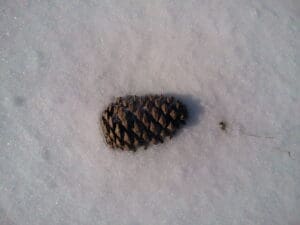
Pine cone in the snow in Myrtle Beach, SC – 01/22/2025. Credit: Jason L. Flynn.
Ironically my initiation of experiencing winter snow in a wild setting firsthand (actually being out in the wild), came in that location of South Carolina (as opposed to experiencing snow in a neighborhood setting, which I had occasionally felt my whole life until then). It must have been early 1992 (possibly late 1991). My brother and I each dressed somewhat warmly trudging through the woods and the big field that was just over the chain link fence while it snowed all day. There was no clear plan other than to walk through it all, explore, and experience it. It was not a heavy snow. Maybe 2 inches fell. But for that day it was a true winter wilderness. As dusk came I’ll never forget the darker grey line of clouds compared to the rest of the cloudy sky that lingered on the far horizon of the field and woods as we went back to the house before it got completely dark for the night. There were many poems of feeling wrapped up in that sight that would not do it justice. For that moment it felt like there was an Alaskan wilderness over that horizon with that tinge of grey-colored clouds welcoming in the nighttime that dominates the winter months.
I was cold. I was tired. I was alive. I was unsupervised for the day’s explorations, except by mother-nature. It all seemed natural. It all seemed right. I had not been told or been exposed to a community of people that felt the field left in-tact with dormant winter plants, and all the bare trees with leaf litter and pine needles scattered artfully by nature itself across the forest floor and fields was an “incorrect” way of taking care of a plant in winter. Apparently the birds, mice, other animals, and the plants themselves in that field missed the message also. That spring of 1992 they sprung anyway, including the first native plant I consciously paid close attention to day in and day out in my life as a sort of adopted landscape plant; a sassafras tree – Sassafras albidum, growing just outside the chain link fence (which I watched grow healthy and fast over the next 5 years).
During those teen years, for no particular reason I can think of other than being a strong feeling I had, winter was my favorite season. Winter seemed too short to me. For a couple of years I would literally break the early spring growth of that sassafras tree off trying to prolong its winter state, as if that action might somehow prolong the season of winter itself. It did not. The tree never stopped growing even after I stopped that freeform action (which I usually gave up on once I felt spring had a real right to be present). It just had a thicker trunk that suddenly became unusually thinner and more branched at a certain height. I had unintentionally reproduced what can happen when a tall tree snaps in the middle due to a storm and regrows a vertical shoot in the middle that does not match, which I have come across in the forest. It knew it was teaching me a lesson that I would not fully comprehend until later in life if I chose to try and understand it.
I can say now that autumn is actually my selfish favorite season. With no disrespect to the tropics intended, if only one season existed I would not have that strong appreciation of autumn or winter. I understand it is all relative and spring into summer is beautiful and full of its own unique mystique that leads to autumn and winter.
Music in Order of Appearance in Article:
- Soundgarden: Been Away Too Long (2012)
- Mercury: Swarm the Hive Mind (2024) (Thank you WUSC-FM 90.5 Columbia, SC for helping introduce this band to the public)
- A Perfect Circle: Disillusioned (2018)
- David Arkenstone: Darkening Skies (2023)
- Vintage Radio: Winter Radio Playlist – The Best of Vintage Music from 1940’s and 1950’s
- Screaming Trees: The Winter Song (1992)
- Kool and the Gang: Winter Sadness (1975)
- Tool: Descending (2019)
- Mercury: Together We are One, You and I (Short Film w/ songs Born Early May, Special, & Crick (2024)
- Merle Haggard: If We Make it Through December (1973)
- Robert Plant: Little By Little (1985)
- Alice in Chains: Heaven Beside You (1995)
- Gordon Lightfoot: Song for a Winter’s Night (1967 and 1975)
- Pearl Jam: Wishlist (1998)
- Stone Temple Pilots: Wicked Garden (1992)
- The Juliana Hatfield Three: For the Birds (1993)
- Pink Floyd: Hey You (1979)
- Marvin Gaye: Inner City Blues (Make Me Wanna Holler) (1971)
- The Smashing Pumpkins: The Beginning is the End is the Beginning (Batman & Robin soundtrack version) (1997)
- Nirvana: Where Did You Sleep Last Night (Live on MTV Unplugged – unedited) (1993)
- Iron Maiden: Stranger in a Strange Land (1986)
- Mike Ratledge: Riddles of the Sphinx Sequence 6 (1977)
- Toad the Wet Sprocket: Inside (1994)
- John Huling: Return to Spiritlands (1998)
Informational Videos in Order of Appearance of Article:
- PBS Naturescene: Winter Beach (1979 – full episode)
- PBS Naturescene: Here Comes Winter (1980 – full episode)
- Closer to the Truth: Michio Kaku: Is Time Travel Possible
- PBS Naturescene: Burches Ferry Overlooking the Pee Dee River in Winter – (Coastal Plain Geology) (1980 – full episode)
- Art Bell’s Midnight in the Desert overnight radio & internet show: full show w/ guest Dr. Kevin Trenberth about Climate Change – September 22, 2015
Documents and Webpages in Order of Appearance of Article:
- South Carolina Native Plant Society: Autumn Blooms Deep
- South Carolina Encyclopedia: Plants
- Brittanica.com: Science: Little Ice Age
- NOAA: Christmas Coastal Snowstorm: December 22-24, 1989
- South Carolina Department of Natural Resources: Climate of South Carolina PDF
- AZO Life Sciences: The Secret Life of Plants: Unveiling Chemical Communication
- Ecotoneinc.com: Aldo Leopold: Thinking like a Mountain
- Pub Med Central: National Library of Medicine: Hunger and Thirst: Issues in measurement and prediction of eating and drinking
- National Park Service: Fifth National Climate Assessment: Alaska Chapter
- Politico Magazine: Why You Won’t Hear the Military Arguing about Climate Change
- NASA: Climate: Ocean Warming
- South Carolina Encyclopedia: Coastal Plain
- WLTX-Columbia, SC: Meteorological winter, which starts December 1, is the fastest-warming season in central South Carolina
- The Conversation: The world’s tropical zone is expanding, and Australia should be worried
- Yale Environment 360: Redrawing the Map: How the World’s Climate Zones Are Shifting
- Vox: Climate: Why Have Our Winters Got so Weird?
- University of Maryland Extension: Native Plants and Climate Change
- South Carolina Native Plant Society: The Native Seed Bank that Surrounds the Pavement
- Holden Forests and Gardens: The Sweet Side of Winter: Carbohydrate Dynamics during Cold Acclimation
- Cornell Botanic Gardens: Sassafras-Native Gem of North America
Winter blessings to you and yours as the Sun and Earth dance bring us back Spring!
Louis Armstrong – What a Wonderful World (Original Spoken Intro Version) (1967, 1970)
Jason L. Flynn
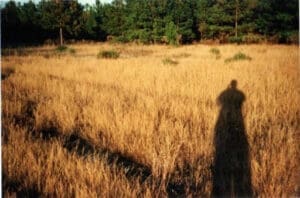
March 19, 2025
South Carolina Native Plant Society – Grand Strand Member
Brookgreen Gardens – Horticulture – creator of the South Carolina Geologic Garden
B.A. in Environmental Studies – V.W.U.

